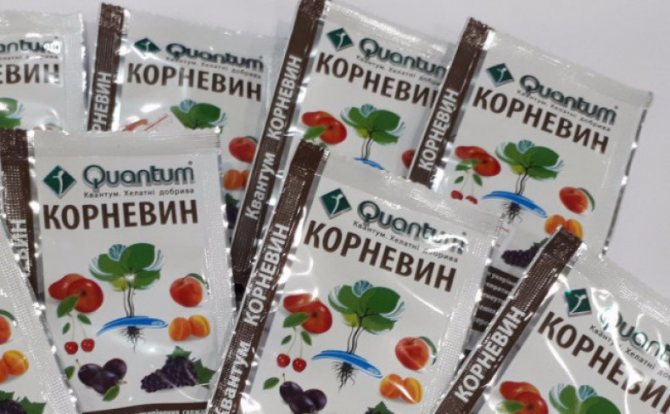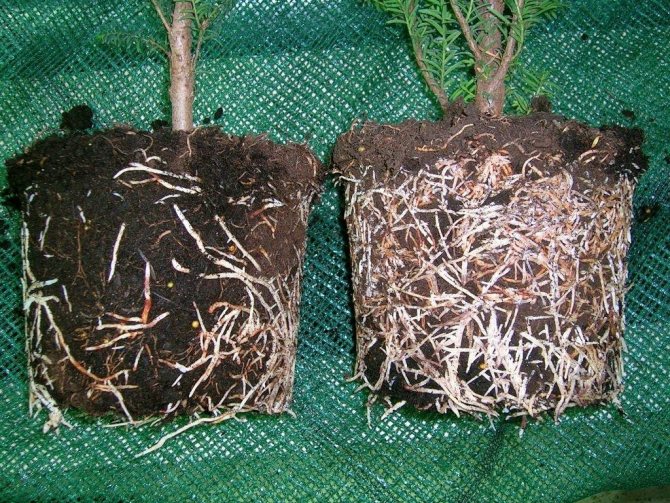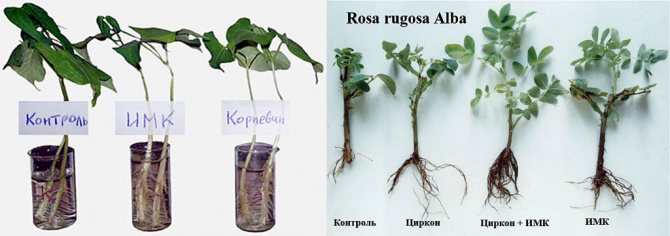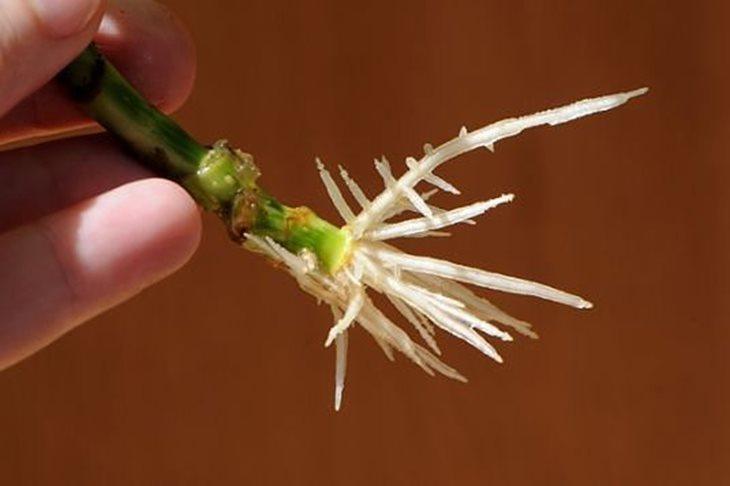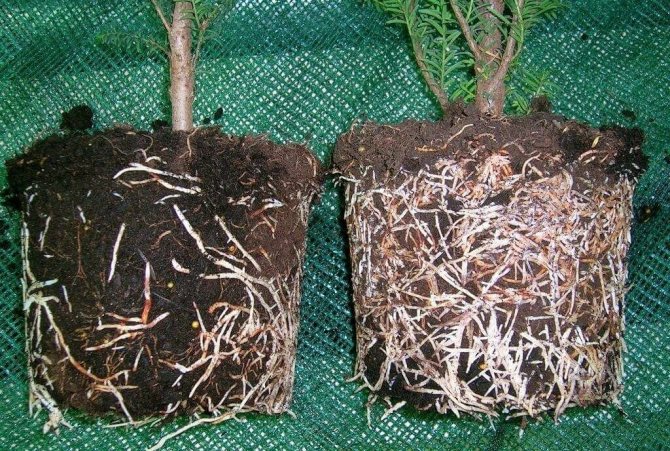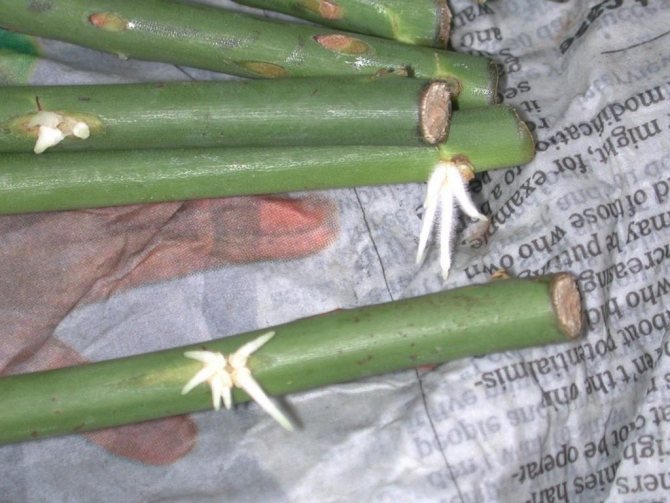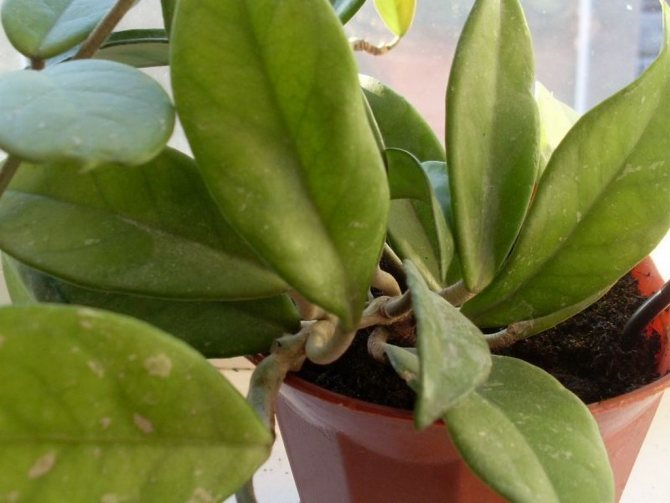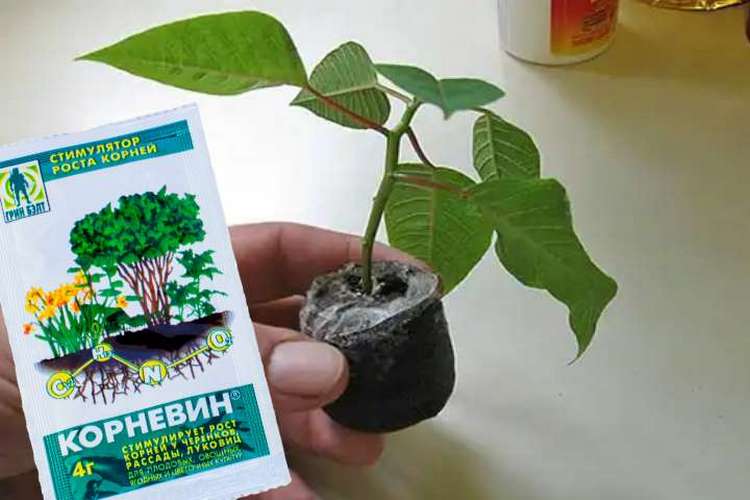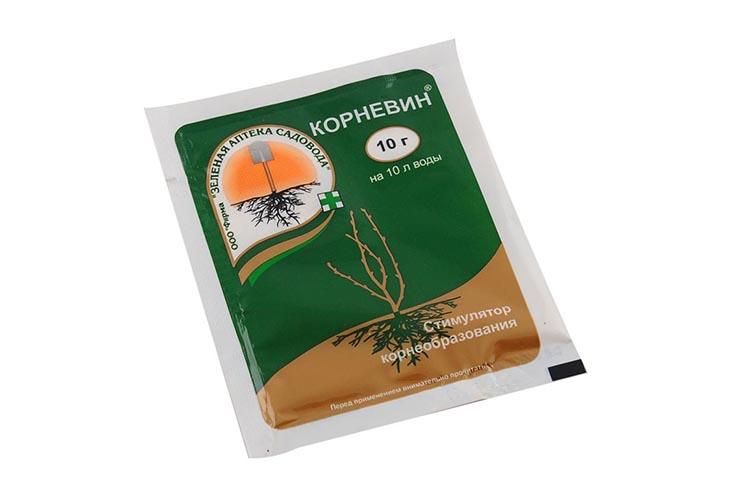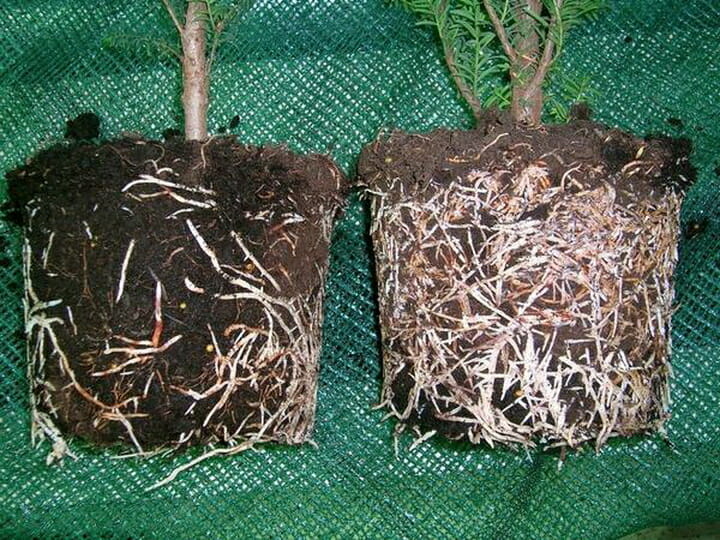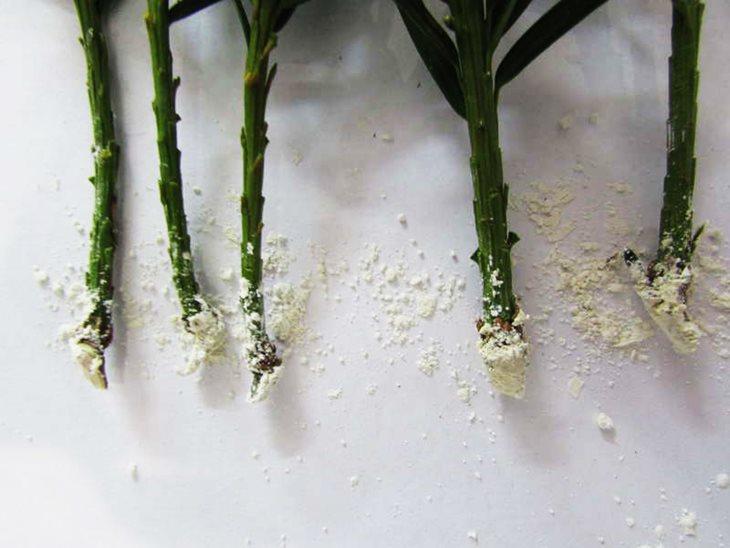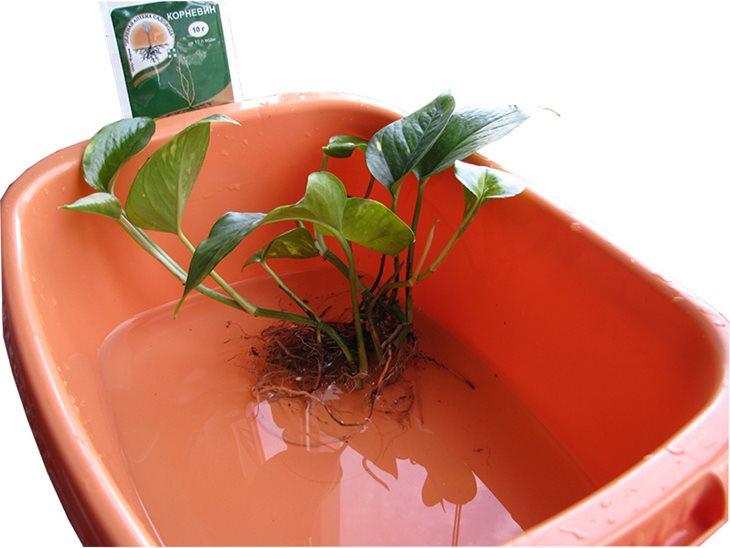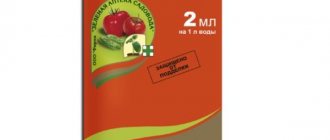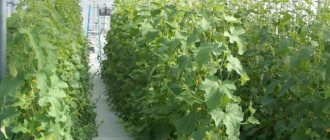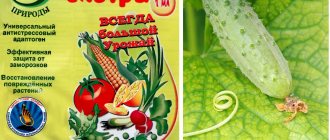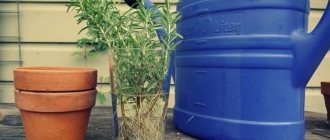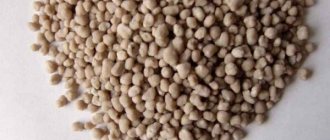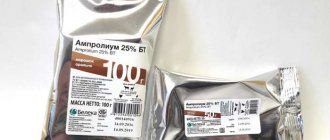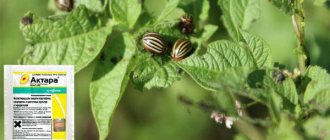Gardeners and gardeners are familiar with the feeling of disappointment that occurs when most of the cuttings do not take root, not all seeds germinate, and the seedlings do not develop well. There can be various explanations for this, one of which is weak root formation. It can be stimulated by means of Kornevin.

We will tell you what is remarkable about the composition for different cultivated plants and why they need to be used. We will give detailed instructions for use, including for roses, seedlings, seedlings and indoor flowers.
Composition and form of release, description of the drug
It has the same effect as heteroauxin (it is considered its analogue), however, the effect manifests itself more slowly, but lasts longer. The composition of Kornevin includes indolylbutyric acid, it is 5 g per 1 kg in the preparation and microelements: phosphorus, potassium, molybdenum and manganese. The drug for sale is packaged in sachets of 4.5, 10, 125 g and packs of 250 g. Inside them there is a fine white or light beige powder.


Composition of the product
The composition of the root formation stimulator "Kornevin" is a concentrated 5 g / kg indolylbutyric acid. It has a mild prolonged action in comparison with similar drugs.
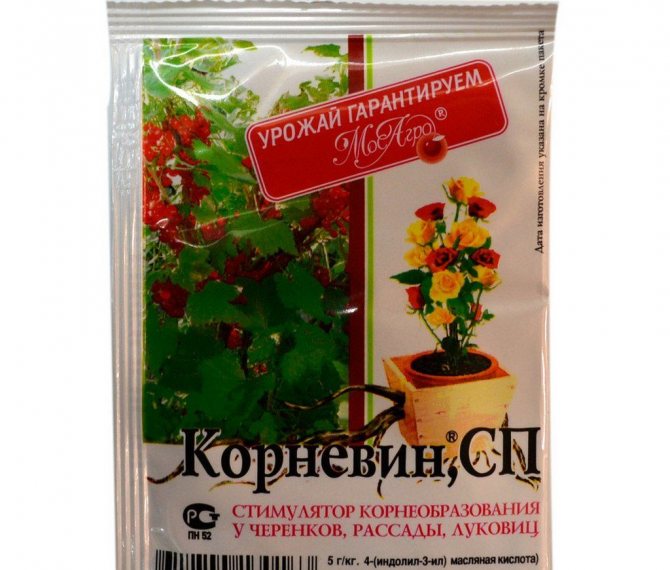

"Kornevin" is a concentrated 5 g / kg indolylbutyric acid
Outwardly, it is a whitish powder that is best stored in a glass container in a dark place. Since the root former is used very sparingly, after opening the factory packaging, it is poured into a dry glass container. Sometimes the name "Kornevin SP" is on sale, this is the same drug, it is simply produced by another manufacturer.
What is the principle of operation intended for?
It is a root former for cuttings, tree seedlings, seedlings and bulbs. The action of the drug is as follows: getting on the surface of the stems or part of the cut cuttings, indolylbutyric acid irritates the upper layer of tissues, which is why callus is formed on them, from which the roots grow. Callus formation is a natural process, but Kornevin only speeds it up.
The drug Kornevin improves the rooting of cuttings and seedlings of fruit and ornamental bushes, trees, grapes, accelerates the survival rate of cuttings and seedlings after transplantation. When picking, Kornevin helps seedlings to take root faster.
The rate of action of the drug is 20-60 days, it is determined by the period of its decomposition to endogenous auxin, which changes depending on the conditions in which the agent is stored.
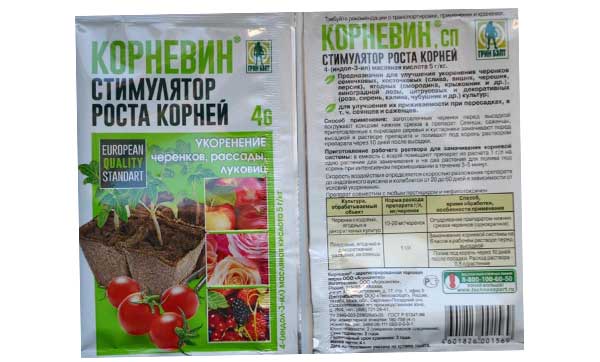

Kornevin cannot be considered a fertilizer, its active ingredient, which belongs to phytohormones, does not nourish plants, cannot protect them from diseases or pests, the drug is not intended for this. Therefore, one cannot rely only on him and neglect standard fertilizers and protective agents.
Short description
Kornevin is a growth stimulant made on the basis of indolylbutyric acid. It has a mild long-term effect on the formation of the root system, which is especially important when propagating plants by cuttings.
The product is a pinkish, white or beige powdery powder, packaged in individual sachets. The biostimulant can be used both in dry form and in the form of a solution.There are several purposes for which Kornevin is used. The most common are:
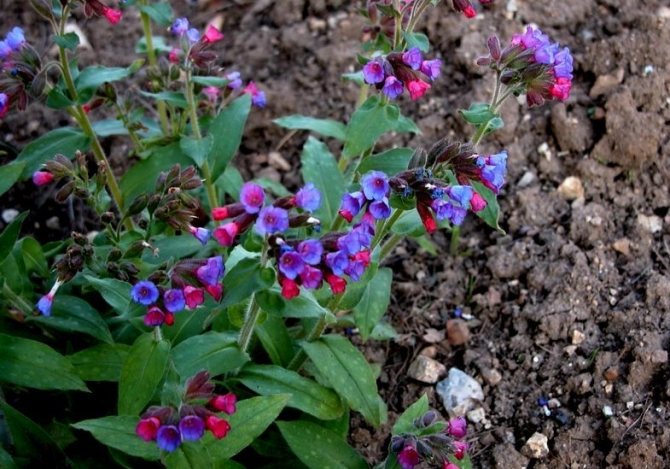

helping seeds germinate;- improved root formation in cuttings;
- reducing the negative impact of complex natural phenomena on the seedling;
- promoting the strengthening of the roots of the planted seedlings.
The active substance of the phytohormone, after getting on the surface of the plant, has an exciting effect on its outer layers, contributing to the formation of roots and callus. In addition, it also accelerates the division of the seedling tissue.
Thanks to the treatment of cuttings with Kornevin, they quickly take root, and the part of the plant immersed in water resists decomposition for much longer.
Advantages and disadvantages of Kornevin
Like any product, it has advantages and disadvantages. Of the advantages of using Kornevin, one can name:
- action on all types of trees, bushes, flowers and vegetables, even those that are difficult to root;
- rooting can be accelerated: in the spring of seedlings or in the fall of seedlings, so that they quickly take root and do not come under the influence of cold or heat with undeveloped roots;
- you can save plants during transplantation, if it is urgently needed;
- a greater effect from the drug than from honey and yeast, which contain natural auxins.
The disadvantages are as follows: an aqueous solution of Kornevin may be weak, and the growth of roots will go slowly, then you need to use a dry powder. At the same time, you need to monitor the consumption rate, if you overdose, then, on the contrary, it will have a depressing effect on the roots.
Recommended to read
Instructions for use of the drug Epin extra
Instructions for the use of succinic acid for plants
How to use boric acid in the garden and vegetable garden
Rules for the use of copper sulfate in gardening
How to replace Kornevin
At home, you can replace Kornevin with natural infusions and decoctions that will work no worse than a chemical preparation. This option will appeal to supporters of organic farming.
There are many recipes, the seeds can be treated with aloe juice, which will additionally perform the functions of fungicides.
Willow water
In the old days, they did not know about any chemical growth stimulants, but the plants were grown no less successfully. Our ancestors used biostimulants, one of which is a decoction of willow or willow twigs.
It is not difficult to prepare it:
- Cut annual branches into pieces, the length of which is 5-6 cm.
- Fill with water so that it covers the plant material.
- Keep on low heat for 30 minutes.
- Remove from the stove, let it brew for 10 hours.
- Strain, pour into glass jars.
Plants can be treated with this broth within a month from the moment of preparation, the effect will not be lost. Store the broth in a cool, dark place. The basement is ideal in this regard.
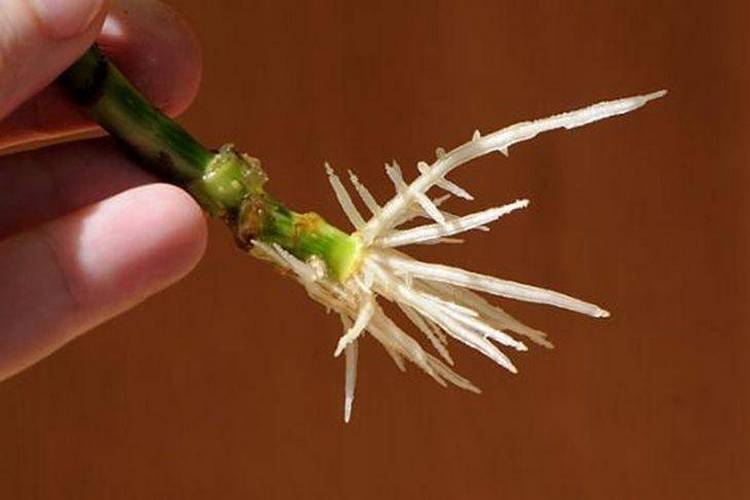

The resulting broth is watered with plants when transplanting or planting in open ground.
Honey water
Natural honey is a powerful stimulant, and also indirectly helps plants in the absorption of nutrients. It is used more often for soaking seeds, but it is possible to process the roots of seedlings and seedlings.
To prepare a solution in a liter of water, dilute a teaspoon of last year's honey. Everything is thoroughly mixed until complete dissolution, then used as directed. To achieve the desired effect, seeds and cuttings must be soaked for at least 12 hours.
Baker's yeast
Another effective plant development stimulant that can be used for seedlings of vegetables and herbs. To prepare a solution in a liter of water, dilute 100 g of yeast, then soak the cuttings for a day. Seedlings are watered a day after transplanting to a permanent place.
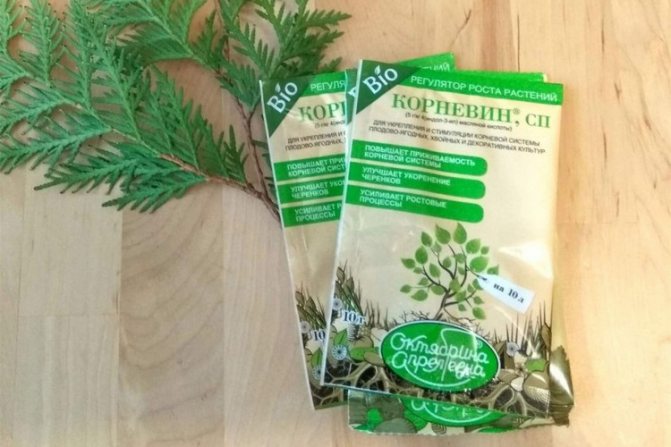

After soaking in a yeast solution, the cuttings are dipped in clean water for several minutes, then sprinkled with earth in a previously prepared place.
Instructions for use
This is a simple substance; to reveal the effect, it does not need to be mixed with anything other than water.
Dry
Kornevin is used in dry and dissolved form. If the method with dry powder is chosen, then you just need to powder the roots of seedlings or seedlings, cuttings of grapes and other plants before planting. The lower part of the cuttings is moistened and sprinkled with the preparation. 1 stalk will need 10-20 mg of the substance.
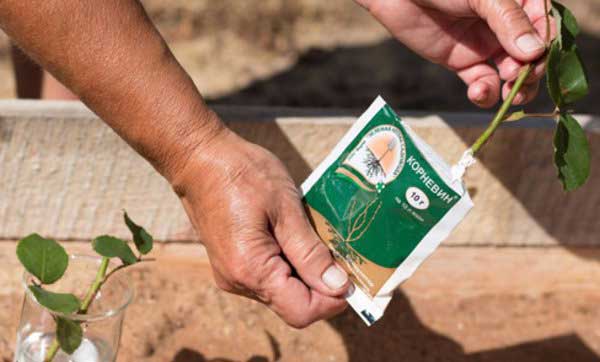

Kornevin for indoor flowers, especially exotic, and therefore finicky, can be dangerous. It is better not to use it for orchids (but if you suddenly really want to try it, then it is used dry, dusting it a little with a brush, in a small amount, only the root collar). The preparation is also suitable for violets. It is much easier to root the plucked leaves of this plant with it. The same can be done with cuttings of begonia, gloxinia, etc. It should not be heavily dipped in powder, it is enough to lower it to a depth of 1 cm, this is enough for root growth. If a lot of powder has adhered, the excess must be shaken off.
In the form of a solution
To use Kornevin in the form of a solution, dissolve 1 g in 1 liter, stir for 3-5 minutes so that all the grains dissolve. Soak plants or seedlings in it for 6 hours before transplanting. The second option is to water them 10 days after planting. Pour 0.5 liters per specimen. It is necessary to breed Kornevin for watering seedlings in the same proportion as for cuttings. Do not soak it, but water it on the day of transplantation. The biostimulant Kornevin will help the rooting of ornamental crops bulbs. Before planting, they are soaked in solution for 18 hours.


Under the seedlings of fruit trees, so that they can grow roots, 2-2.5 liters of liquid are poured. For bushes - 0.3 l, for seedlings of tomatoes, cucumbers, strawberry rosettes or other vegetables - 50-60 ml per 1 copy. For flowers, for example, for petunias - 30-40 ml. Indoor flowers can be watered when transplanting from a pot to a pot, and garden flowers, for example, chrysanthemums, when planting in a flower bed in spring. Kornevin is especially useful for conifers, which are usually difficult to root. Gardeners recommend Kornevin for roses, when replanting a bush and for the same cuttings.
When diluting, it is important to remember that there is 1 gram of this substance in a teaspoon. It is better to dilute Kornevin in warm water, it dissolves faster in it.
Security measures when working with "Kornevin"
When using the drug "Kornevin", the following safety measures must be taken: • During the work with the biostimulant, do not eat or smoke; • After completing the work, be sure to wash your face and hands with soap; • The released container must be burned or disposed of in a specially designated place; • If the powder accidentally spilled out, it must be covered with sand or soil, then carefully collected and disposed of; • If the drug gets on the skin, wash it with soap and water; • If the drug gets into the eyes, immediately rinse the eyes with plenty of water; • If the drug has entered the mouth, rinse your mouth and drink as much water as possible. This is necessary in order to induce vomiting. Having cleared the stomach in this way, you should take 4-5 tablets of activated carbon and drink a glass of water. If the measures taken did not have the desired effect, you should contact a medical institution.
It is necessary to work with the drug in special clothing and with special equipment that protects all parts of the body, respiratory organs and eyes. After completing the work, you must thoroughly rinse your hands with soap and water and be sure to rinse your mouth.
Testimonials
Gardeners who do not forget to use Kornevin for plants leave such reviews.
I always buy this product for rooting cuttings. It is inexpensive, in convenient small packages, it is consumed well, there are almost no leftovers. It is necessary to dilute the substance and keep the plants in it as written in the instructions, the main thing is not to exceed the dosage. Sylvester
The use of Kornevin for seedlings has repeatedly given a positive result. Processed tomatoes and cucumbers take root much faster, especially if the weather is unfavorable. If you use Kornevin for cuttings, then they take root much more actively than not soaked, this can be seen even visually: the roots are longer, there are more of them, so the drug works. It helps plants at one of the most important stages of their life. Anatoly
You can water Kornevin with anything you want during planting or transplanting. It is also suitable for seedlings, vegetable seedlings, flower crops, flower bulbs, and rose cuttings. They all respond very well to it. I did not notice any harm from him. Sergey
Substitutes
In many cases, for rooting cuttings (except, perhaps, conifers), the purchased root can be replaced with biostimulants of root formation from natural products containing BCIs:
- A teaspoon of honey is diluted in a liter of water. The cuttings are kept in the solution for 10-12 hours, then planted in the ground. The rest of the solution is poured into the root hole.
- 100 g of baker's yeast is diluted in 1 liter of warm water. The cuttings are soaked in the solution for a day and planted in place.
The percentage of rooted cuttings after such treatment is lower than from the root, but there is no danger of burning cuttings with the drug. On the other hand, observing the process of vegetative reproduction will give an experience that will make it possible to successfully switch to the use of root and other strong biostimulants.
We cannot do without fertilizers in our gardening business, everyone knows that. What kind of feeding we do not use: mineral, organic, bacterial, complex fertilizers and others. After all, I really want to get a record harvest in the country and improve the decorative look of our favorites, planted just "for the soul." "Kornevin"
Science does not stand still in this area. In the last decade, a new series of biostimulants (phytohormones) has appeared on the market, significantly strengthening the immune system of plants and stimulating their root formation. This series also includes “Kornevin " (analogue of heteroauxin), which we call fertilizer in the old fashioned way. But this is not true, "Kornevin" is not a fertilizer and is not capable of replacing mineral, organic, bacterial feeding of plants, but it suits perfectly to ensure the active vital activity of the roots of our green pets. I will not go into phraseological subtleties, let's talk better about the properties of this powerful biostimulant and how to use it.
Indications for use
So, based on the properties and characteristics of the root, it is preferable to apply it in the next. cases:
Note: to process seeds with root to increase germination, as is sometimes advised, is pointless. BCI has no noticeable beneficial effect on seeds.
Rooting
Root cuttings can be rooted dry and with a solution. The dry method (see below) is more effective, but it requires a higher consumption of the drug and entails a greater risk of rotting of the cuttings. It is used if cuttings of this type do not take root with a solution. The dry method is applicable after an attempt at rooting with a solution, if callus does not form after 1-2 weeks after treatment.For diagnostics, examine the stalk under a magnifying glass: if at least tiny nodules are noticeable, continue rooting with a solution. Instructions for rooting wood cuttings using a root solution looks like a trace. way:
- A basic root solution is prepared: 1 g of the drug per 1 liter of water, see above;
- Cut off a stalk with 3-4 leaves;
- The lower leaf is cut (do not rip off!) So that a piece of its petiole covers the leaf bud;
- The cut is dried with filter paper;
- The cuttings are dried in the shade at room temperature until the release of juice stops (usually 1-4 hours);
- The stalk is kept in the basic solution of the root for 10-15 minutes, immersed along the petiole of the cut leaf. The solution must not cover the leaf bud!
- While the stalk is standing in the solution, 5-7 tablets of activated carbon are pounded;
- If rooting is in water, pour crushed coal into it. For rooting in the soil, coal powder is mixed with it. The rooting substrate must be prepared in advance: calcined, treated with a biocide, etc. In either case, a pinch of coal powder is left;
- The stalk is removed from the solution and, while still wet, is "dipped" into crushed coal for disinfection. Charcoal powder to plants is the same as brilliant green, iodine or mercurochrome to us;
- The stalk is placed / planted in a rooting dish;
- If rooting is carried out in water, and the roots are not visible, after a week and, possibly, another week, the tip of the cutting is examined under a magnifying glass (see above). If there are signs of callus formation (pinpoint swellings like awakening buds), the cutting is planted in a peat-peat pot with greenhouse soil and watered daily (1-3 tablespoons). You can cover with a jar, which is removed in the morning and evening for 10-20 minutes for airing.

